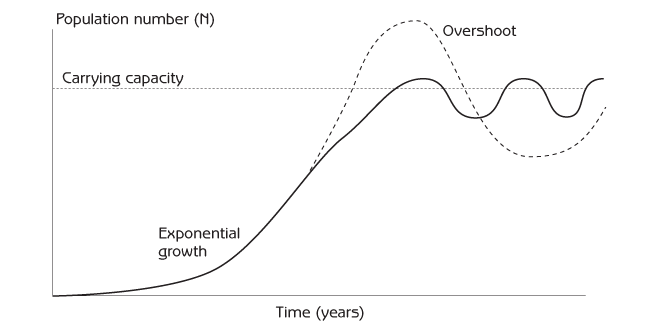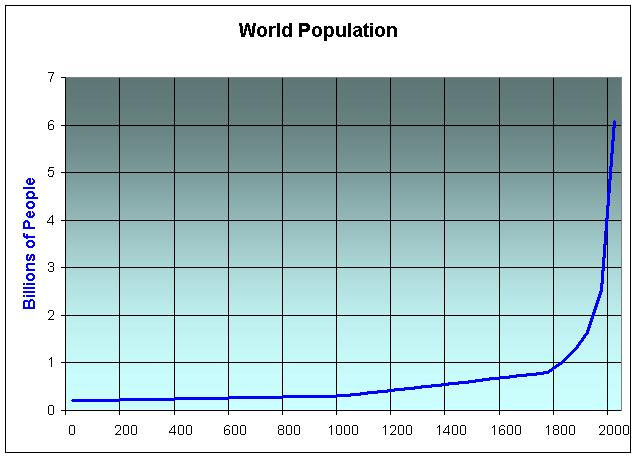Introduction
Carrying capacity refers to the size of the population of a certain living organism that the environment can sustain while the organisms basic needs remain available according to Chefurka (2009, para.5-6). Carrying capacity directly affects population growth of not only that specific species, but also others species that are directly affected by their effect on the environment. When studying population growth, it is therefore imperative for factors affecting the carrying capacity to be considered.
Factors limiting exponential population growth
These are grouped either as density-dependent or density-independent factors based on whether the factors are affected by the population size. Density-dependent factors are biological in nature, greatly affect constant environments and also larger organisms. An example of such factors is intra-specific and inter-specific competition for resources; a significant change in either may adversely affect population growth due to increase or decrease in resources that changes the carrying capacity for the organism. Predation is also another major factor since the carrying capacity changes with a change in the number of predators and thus the growth of the population is affected according to Campbell and Reece (2005, pp.303-321). There are other factors that may alter the carrying capacity and thus, the growth of a population such as, migration into or out of a certain ecological niche or parasitism that can lead to diseases.
Density-independent factors are physical in nature, have greater effect on extreme environments and also on smaller organisms. Examples of such factors are extreme weather conditions like delayed rainfall, flooding due to increased precipitation and generally other factors affecting the habitat of these organisms. Such factors reduce the carrying capacity of the environment and thus impact negatively on population growth as also shown by Campbell and Reece (2005, pp.322-336). These factors have a much more profound and drastic effect on the population size and can wipe out entire populations.
Natural and human population comparisons
Humans have adapted to factors that have adverse effects on other species. This is due to the technological developments and advancements achieved. While these developments may not be uniformly spread to all people due to social and economic class differences, some like shelter remain common to all. However, man is not shielded from all the limiting factors and as such any change to food supply is seen to also affect population growth particularly in developing countries. Migration mainly from rural to urban areas is also seen to affect the population growth in both areas. Natural disasters that can be viewed as density-independent factors are also seen to affect human populations. Diseases may also affect both populations, but the mortality rate is reduced for humans due to advancements in medical care.
While humans have succeeded in eliminating some factors like predation, they have also created other factors that affect their population growth, the major one being economic ability. This is a prerequisite to providing for a family and thus can affect the growth of a population. Another emerging factor not associated with natural population is the levels of education in a given society and its quality. This is because the education leads to adoption of different values about the family thus, on average families in developed countries with better education are smaller than those in developing countries. Such aspects ensure that the world human population will continue to grow but it will reach a certain carrying capacity where the diminishing natural resources and other man made factors will occasion a fall in population.
Graphs

An exponentially growing population reaches and oscillates around its carrying capacity. The solid curve according to Marten (2001, para. 24-30) shows normal growth for an organism up to the carrying capacity. On reaching the carrying capacity, the population size starts oscillating around the carrying capacity due to reasons that include the effect of other limiting factors. The dotted line shows what might happen should an organism overshoot beyond its carrying capacity. As can be observed, the upsurge is followed by a sharp downfall in the population size to well below the carrying capacity.

The above growth can be seen to represent an uncompleted and rather unnatural sigmoid graph with a progressively long lag phase and a very steep exponential growth phase. The reason for such a huge difference is due to the technological advancements of man beginning in the 1800’s and accelerating from the 1900’s onwards. Man has been able to adapt the environment to the best of his ability to further his spread and growth in the world and it is worth noting that the upsurge should be countered by sharp falls as the years go by.
Conclusion
Human population numbers will remain on the rise, particularly in the low and middle-income nations that will greater growth. The effect on the natural population by man will increase as the search for more space and resources continue and his actions on the environment begin to take their toll. Such growth cannot be sustained over the long run and hence a sharp fall must follow before eventual leveling off.
References List
Campbell, N.A. & Reece, J.B. (2005).Biology Seventh Edition. New York. Benjamin Cummings.
Chefurka, P. (2009). Population, the Elephant in the Room. Web.
Marten, G. G. (2001). Human Ecology: Populations and Feedback Systems. Web.